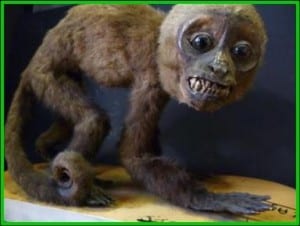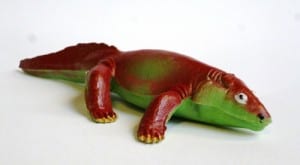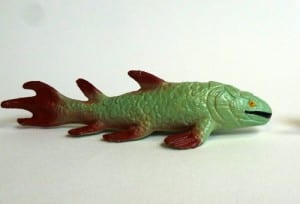Specimen of the Week: Week 156 (The Evolution of Life on Land)
By Jack Ashby, on 6 October 2014
 It’s the third birthday of the Specimen of the Week blogs, so this one is a special one, tackling one of the biggest events in global history (no exaggeration). It’s also the start of winter term at UCL, and that means that Grant Museum returns to doing the very thing our collections were first put together for – spending the day teaching students about life.
It’s the third birthday of the Specimen of the Week blogs, so this one is a special one, tackling one of the biggest events in global history (no exaggeration). It’s also the start of winter term at UCL, and that means that Grant Museum returns to doing the very thing our collections were first put together for – spending the day teaching students about life.
This term every week we have a palaeobiology class where the students learn about vertebrate life from the beginning – looking at each group in turn as they evolve in the fossil record. That has inspired my choice of specimen this week.
As an Australian mammal nerd, it’s often tempting to think that nothing interesting happened between the appearance of multi-cellular life a little over 500 million years ago, and 200 million years ago when the first platypus-ish things appeared*. However, sometimes it’s important to think about where it all began: the fishy animals without which there would be no you, no me, no internet cats, and no platypuses.
This week’s specimen of the week is…
**The naff model of Ichthythostega**
We all know that vertebrate life on land evolved from fishy things turning into amphibiany things – we’ve all seen the Guinness advert which taught us the basics**. What I’d like to consider is what characteristics the fish needed to evolve in order to survive on land, and become tetrapods – the land-based group which contains amphibians, reptiles, mammals and birds.
These characteristics are found in the least underwhelming of all fish: Ichythostega. Ichthyostega is so un-underwhelming that it would be fair to call it an amphibian (or a tetrapod), but as “fish” doesn’t actually have a biological definition please don’t write in to complain.
Unfortunately, this Starlux model is the only Ichthyostega “specimen” we have in the Museum. It’s one of a hundred or so similar models of extinct organisms one of our predecessors saw fit to officially accession into the collection. It has a number and everything. [Curator Mark listed one of them as his Favourite Specimen in the Museum]
1) In order to consider the characteristics necessary for life on land, it’s important to examine what characteristics the animals which gave rise to tetrapods had, since evolution can only work on things that are already there. These ancestors are the “Osteolepiforms”, like Eusthenopteron. This fishy animal had a pectoral fin with a simple humerus articulating with a radius, an ulna and the “shoulder” (if fish have shoulders); no real digits; but crucially – different to what came before – is the presence of an interclavicle bone, giving stability to the limbs’ frame. These are all precursors to moving on land. Like other fish its head was solidly sutured to the shoulder girdle.
2) For a fish like Eusthenopteron to walk on land, what changes were required of the skeleton? The most obvious character is that legs need to develop from fins. Locomotion on land is vastly different from that in water in three main ways:
a) It must be entirely limb-driven – while swishing your body sideways like a fish can increase the stride length on land (think of lizards and crocodiles), the force of the step comes from the legs. Compare this to the tail-driven swimming of fish.
b) Moving on land is far more energetically demanding – the body is not being supported by water, so the role of the skeleton in supporting the weight must be increased.
3) If you squint, you can see solutions to these needs on the naff Starlux model of Ichthyostega, one of the very first tetrapods from the early Devonian period.:
a) This animal had four legs. And digits (FISH FINGERS!) – eight of them on each limb.
b) On the forelimb, a small point of bone sticks out in the elbow – this is the olecranon process – it’s where muscles attached to straighten the limb, and it’s the thing that stops you from bending your elbow in the wrong direction – critical for bearing body weight on all fours.
c) A massive advance from the situation in Eusthenopteron is that the bones which support the hind fins/limbs are attached to spine and thus provide some solid support. In earlier “fish” the pelvis just floated in muscle, but Ichthyostega‘s ilium joins to the vertebra via sacral ribs, and the pubis and ischium have grown down and round to meet each others’ counterpart under the belly, forming an all round pelvic basket. In this way the hind limbs can support the animal’s weight under gravity on land.
d) Ichthyostega‘s ribs are unusually massive – they are broad and overlap considerably to form a near solid wall. This supports against the effects of gravity, and provides sites for muscle attachment for flexing muscles.
4) The difference that I think most people miss between fish and tetrapods is that fish don’t have necks. Why is that important? In Ichthyostega the shoulder girdle is no longer fused to the head (you can tell this because the naff Starlux model has a wrinkly neck. Not so naff after all, eh?). This stops jarring vibrations having such an impact on the brain and skull, and frees up any ties between locomotion and feeding (try wearing a neck brace whilst walking and drinking a cup of tea to see why that’s important).
5) Ichthyostega has also developed new articulating processes on the vertebrae, called zygopophyses, which means the weight held by one vertebra is held up by the next one, spreading the weight all down the spine.
It’s through these adaptations that fish were able to walk onto the land, turn into amphibians, and then through a number of steps until we finally get a platypus. Thanks Ichthyostega. I mean it.
* Technically this is the date of the earliest Prototherians, which would later give rise to the Monotremata – platypuses and echidnas. The first platypus-like monotremes, Steropodon and Teinolophus appear 120 million years ago. Do you like how I’ve managed to make a blog about fossil amphibian-fish fish actually about platypuses?
** Dear pedants, we all know that the mud-skippers which feature in the Guinness advert did not give rise to vertebrate life on land. Get over it.
Jack Ashby is the Manager of the Grant Museum of Zoology
2 Responses to “Specimen of the Week: Week 156 (The Evolution of Life on Land)”
- 1
-
2
Specimen of the Week: Week 157 (an exciting rediscovery?) | UCL UCL Museums & Collections Blog wrote on 13 October 2014:

[…] nicely on from Jack’s evolution of life on land specimens of the week last week, we’re sticking to specimens in our ‘MEET THE ANCESTORS’ case. This week’s […]
 Close
Close





Wow! Please show more plastic models of extinct animals. It took me absolutely ages to hunt down a plastic model anomalocaris for my son (it was on his Christmas list), and frankly, the one I managed to find isn’t all that good. But our plastic Dunkleosteus is a corker.